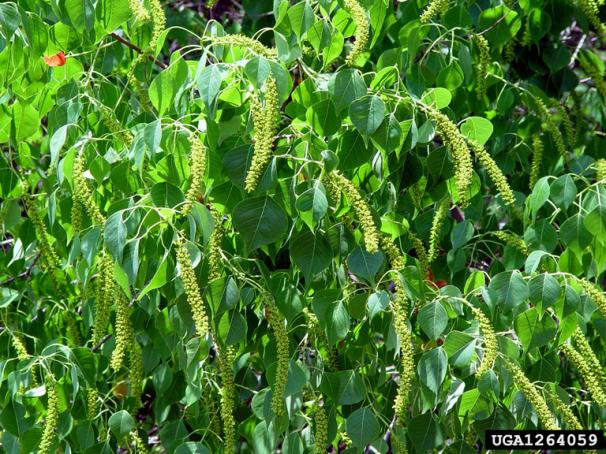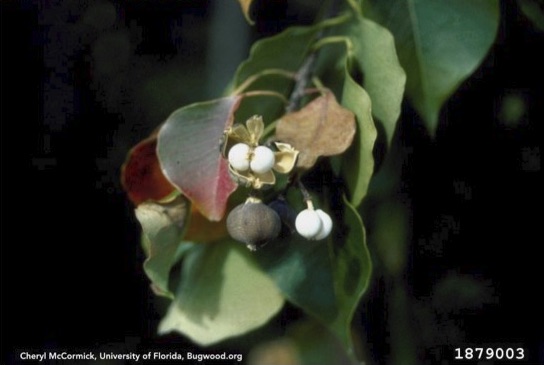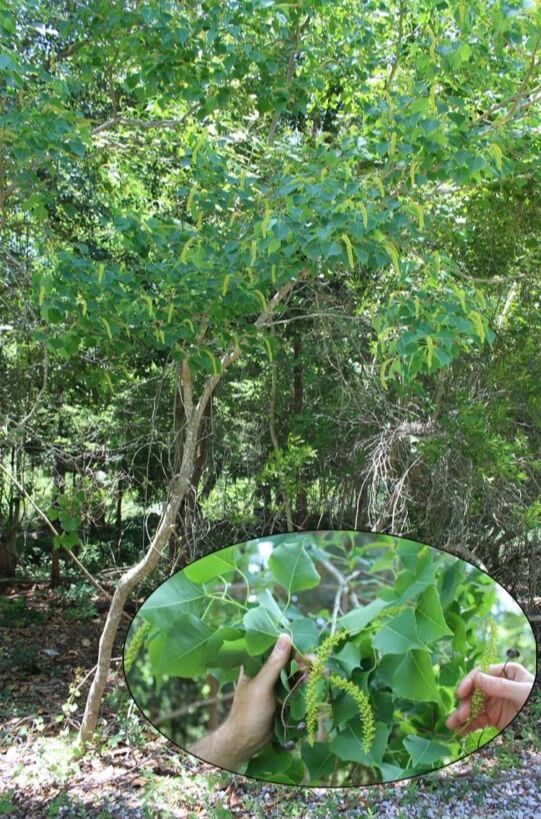Chinese Tallow Tree
Also known as the Popcorn Tree, the Chinese Tallow Tree is one of the top 10 most invasive plants in Mississippi. Popcorn trees spread like wildfire, overtaking native vegetation, damaging wildlife habitats, and destroy nature's balance. Popcorn trees have distinct, heart-shaped leaves, dangling yellow flowers, and fruit that looks like popcorn.

About the Chinese Tallow Tree
The Chinese tallow tree is a popular ornamental because of its fast growth rate, attractive fall color, and ability to resist damage from pests. It is a small tree that grows to about 20 feet tall, but some specimens can reach up to 50 feet. It freely branches, with leaves arranged alternately on the branches. The leaves have acuminate tips and entire margins, with broadly ovate leaf blades and rounded bases.
The Chinese tallow tree has flowers attractive to bees and other insects. It produces three-lobed capsule fruit that ripens from August to November. The tree is deciduous and has a strong, deep taproot, which enables young trees to withstand periods of drought. Birds and moving water spread seeds.

Threat
Chinese tallow can invade almost all habitats, from wet to dry and sun to shade. It often grows along roadsides, coastal areas, and streams. Some specimens can produce up to 100,000 seeds that birds may eat and disperse. Regrowth often occurs from cut stumps or roots.
Once Chinese tallow becomes established, native species are crowded out. The leaves and fruit are toxic to cattle and cause nausea and other human sicknesses.

Control
Prevention is an important control tactic for Chinese tallow. Landowners and homeowners are encouraged to remove full-grown trees and seedlings from their property.
Seedlings should be continually pulled by hand before they reach maturity. Alternative trees similar in size, such as blackgum, maples, dogwood, and crape myrtles, can be planted in areas previously occupied by Chinese tallow.
Mature trees should be cut down with a chainsaw. The final cut should be as close to the ground and level as possible. This will make an herbicide application easier and prevent resprouting from the cut.
Seedling trees can be mowed or disked when small. Burning is also very effective for both small and larger trees. No known biological control agents are available to control Chinese tallow; however, it can be achieved with triclopyr ester applied in an oil diluent.
- Cut down large trees with a chainsaw and treat the outer two inches of the cut surface of the stump with undiluted glyphosate concentrate or a triclopyr-based product.
- Large saplings can be treated similarly, taking care to treat the entire cut surface.
- If seed capsules are present on cut limbs, collect and bag these and dispose of them in a heavy garbage bag so they do not spread.
- Monitor for seedlings and continue control as needed.
Report Popcorn Trees with the MS Invasive Species Tracking App
The Chinese Tallow Tree looks attractive and ornamental, but it is highly invasive and will quickly damage the native ecosystem wherever it is planted. By reporting the location of these trees, you can help MFC get a complete picture of Mississippi’s popcorn tree problem, which is the first step to combating the spread of this invasive species.
Help stop the spread of this invasive species by reporting sightings in the app.
Municipal Assistance for Popcorn Trees
MFC accepts applications from municipal governments statewide to assist with popcorn control on public property. To apply, please contact:
Alex Ballard
aballard@mfc.ms.gov
More Information and Further Reading
- Watch MFC’s Popcorn Tree PSA
- Download the Chinese Tallow Tree Plant Guide from USDA’s Natural Resources Conservation Service.
